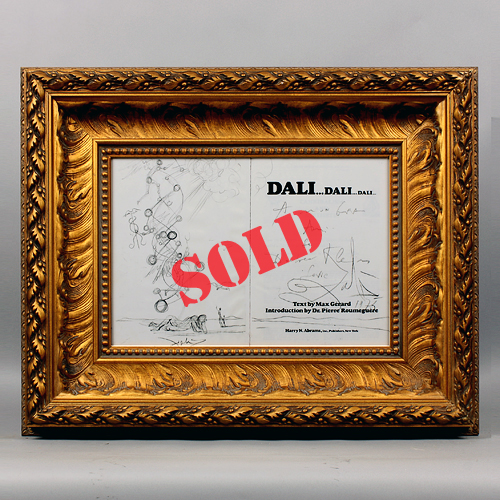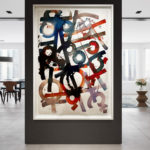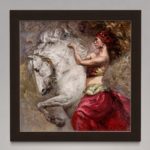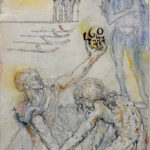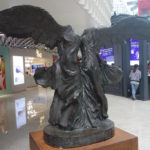Dali & DNA (1975)
Black crayon on book “Dali…Dali… Dali” by Max Gerard, 17” x 12” (43.2cm x 30.5cm)
Amy Klein, one of Dr. Edmund Klein’s daughters- now an attorney in Buffalo (NY) says, “I shall never forget my father’s rendition of his conversation with Dali, as Dali had his sketchbook and pen in hand. They were discussing the philosophical aspects of the merging between medicine and religion. Out of this discussion came Dali’s version of Jacob’s ladder, comprised of DNA molecules intertwined with the angels ascending to Heaven. The second angel represents my father with the medical staff in hand.”
The Biblical account of Jacob’s ladder bears repeating here as it sheds additional light on this Dali drawing:
“Jacob left Beersheba, and went toward Haran. He came to the place and stayed there that night, because the sun had set. Taking one of the stones of the place, he put it under his head and lay down in that place to sleep. And he dreamed that there was a ladder set up on the earth, and the top of it reached to Heaven; and behold, the angels of God were ascending and descending upon it!… then Jacob awoke from his sleep and said ‘Surely the Lord is in this place; and I did not know it.’ And he was afraid, and said, ‘This is none other than the house of God, and this is his gate of Heaven.’”
Thus, we see the sleeping figure, Jacob, at the bottom of the drawing, and to the right of it, the familiar figure of a man walking while holding hands with a child- known to be Dali’s frequent representation of himself and his father. Just above those figures appears at first glance to be a bird, but is more likely another angelic figure, seemingly adrift from the others- perhaps a fallen angel. The other angels align with the molecules of the double helix spiral of DNA, in which the scientifically minded Dali was long fascinated. He created many works during his Nuclear-Mystical Period in which molecules, atoms, protons and genetic structure of the DNA molecule figured prominently- including the painting with the longest single-word title of any Dali work: Galacidalacidesoxiribonucleaicacid of 1963. Dali’s major works of that time also linked his renewed interest in religion with prevailing discoveries in science.
Salvador Dali believed DNA was the ultimate proof for the existence of God. Now, incredibly, DNA experts and forensic scientists are actually looking at Dali’s DNA- reportedly through samples taken from his feeding tube- to try to decode the genetic makeup of creative genius.
This marvelous drawing was executed in the book, Dali…Dali…Dali, by Max Gerard- which is a smaller-sized later version of a book whose dust jacket Dali designed, and which won a European award for cover design. Dali’s inspiration: the gold foil packaging of a box of chocolates!
It is useful to compare the present drawing to Dali’s “Tree of Life” gouache and pencil of 1976, which was one of the original maquettes for the highly regarded “Alchemy of Philosophers” suite of lithographs published the same year.
This is the story of two great 20th century pioneers who came together in a remarkable union of medical and artistic genius: Dr. Edmund Klein and painter Salvador Dali. It resulted in a unique collection of original drawings that… have never before been seen by the art world.

Dali’s Guardian Angel:
Thirteen Dali drawings, plus a Dali sculpture, represent not only a veryspecial collection of art, but an intriguing page of art history.

The collection of Dr. Edmund Klein
Another work, referred to as Dali & DNA, featured three angelic figures-one holding a caduceus (medical staff), intended to represent Dr. Klein himself. Thus, from 1972 to the early 1980’s, Dr. Klein acquired an impressive collection of one-of-a-kind dedicatory drawings, most executed on blank pages of Dali books the artist would bring with him, create in, then give to his surrealist soul mate. Several were drawn in Dali’s sketchbook, another in a rare exhibition catalog. One Dali sculpture, called St. John the Baptist- fashioned directly from Dali’s hands, not merely produced by artisans working off a Dali design- is also part of the Klein collection, together with a unique authenticating statement written by Dali himself.
Black fountain pen of sketchpad, 11” x 14” (28cm x 35.6cm)

Dermatology (From the collection of the late Dr. Edmund Klein)
Dali drew numerous horses duringhis prolific career, but seldom if ever a horse being walked by another person. The horse and rider motif symbolized a sense of importance, leadership and heroism. The Klein family recalls it being explained to Dr. Klein by Dali that the steed’s rider here is supposed to represent Dali, while the man guiding its direction is meant to be Dr. Klein, just as Dr. Klein led Dali in the right direction with respect to his medical issues. The work was drawn on Dali’s sketchpad; it’s unclear precisely what is written in Dali’s handwriting, but it is obviously related to dermatology.
Black ink on paper, 8” x 11” (20cm x 28cm) Paper size

Pour Mon Ami Klein (March 1979) (From the collection of the late Dr. Edmund Klein)
Here is a positively delightful sketch that places a bold Dali signature upon a leaf, from whose tip we see three drops-tears of joy, perhaps? For we know Dali was overjoyed indeed over his relationship with Dr. Klein, who some have said may actually have cured Dali of a form of skin cancer, though it remains speculation and was really only known for sure by doctor and patient. In any case, this inscribed work, “For my friend,” as Dali wrote in French, is one of the few that includes the month written in Dali’s handwriting, as well as the year. The ubiquitous trademark figure of the man holding the child’s hand-known to represent Dali and his father- makes another appearance in this truly charming little work in ink. The large Dali signature somewhat loosely resembles a large snail- a favorite element of Dali’s iconography- and he produced at least one work showing an over-sized snail crawling on a leaf. This Dali sketch was made on the back of the cover page of a technical paper written by Dr. Klein. There is a small tear in the upper right portion of the paper, not affecting the image.
Fountain pen ink on paper, 9” x 11” (22.8cm x 28cm) Paper size

Pour mon Angel le Doctor Klein (1978)
The angel theme informs much of the Klein Collection, and the angel in this delightful 1978 work might be characterized as a bit seductive! The long-legged angelic figure is in the au naturel, striking a pose calculated to draw attention, beyond that which would already be assured through her marked inhibition. Dali considered Dr. Klein his “guardian angel” for helping him with a medical condition that has never been fully disclosed and quite likely will always remain a mystery.

Dali & DNA (1975) (From the collection of the late Dr. Edmund Klein)
The Biblical account of Jacob’s ladder bears repeating here as it sheds additional light on this Dali drawing: “Jacob left Beersheba, and went toward Haran. He came to the place and stayed there that night, because the sun had set. Taking one of the stones of the place, he put it under his head and lay down in that place to sleep. And he dreamed that there was a ladder set up on the earth, and the top of it reached to Heaven; and behold, the angels of God were ascending and descending upon it!… then Jacob awoke from his sleep and said ‘Surely the Lord is in this place; and I did not know it.’ And he was afraid, and said, ‘This is none other than the house of God, and this is his gate of Heaven.’”

Guardian Angel No. II (1976) (From the collection of the late Dr. Edmund Klein)
Dedicated to Dr. Klein, the work featured the words “guardian angel” in Dali’s handwriting, along with this important hand-written designation: “No. II. First = Gala”. This, of course, meant Dr. Klein was second only to Gala (Dali’s beloved wife) as his reigning guardian angel! This realization is more significant than one might first imagine. Clearly Dali was hyper-aware of his mortality, and was facing this inevitability when he first enlisted the intervention of Dr. Klein. Although the details are unknown, it is clear that Dr. Klein helped Dali get through and go beyond his medical concerns. Dali putting Dr. Klein second only to Gala as his “Guardian Angel” speaks volumes about the painter’s feelings for his physician. It is also significant to note that one of Dali’s most important paintings in the 1952 work, “The Angel of Port Lligat”, which portrays his wife Gala as a winged angel along the shore of their Spanish Home. Moreover, one of the watercolors in the collection of Mrs. Albert D. Lasker, whose Foundation honored the work of Dr. Klein, was “Guardian Angel of Cadaques” of 1943.
Black crayon in book “Dali by Dali”, 10.5” x 7.5” (26.7cm x 19cm)

Drawing in Dali by Dali (From the collection of the late Dr. Edmund Klein)
How fitting that Dali would choose his own book- that is, a book he conceived and authored- to create
one of his finest original drawings, this one in black crayon. It is dedicated not only to his friend, but to his “great friend, Dr. Edmund Klein.”
Ink in book, World of Salvador Dali (1980), full spread, 19.5” x 12” (49.5cm x 30.5cm)

Two Drawings in the World of Salvador Dali (1980) (From the collection of the late Dr. Edmund Klein)
These two sketches, made very late in Dali’s artistic life (1980) show signs of Dali’s weakened condition and unsteady hand. Yet they are nonetheless delightful and reveal his dedication to and appreciation of his friend and physician, Dr. Klein. The work at left brings us Don Klein and Dali are connected. The drawing at right, where Dali again refers to Dr. Klein as his “angel”, depicts a kneeling angel with an olive branch of peace.

Triple Drawing (1977) (From the collection of the late Dr. Edmund Klein)
Drawn in 1977 in book, DALI, edited by David Larkin two of these three works capture the pride a spirit of Don Quixote, one of Dali’s favorite stories and a character after which he patterned his own conquering spirit. A delightful Don Quixote figure at the top, made up of squiggly lines (and a ruffled collar) holds a shield and spear- the latter also forming the “P” in the dedication, “pour mon gran ami (for my great friend) Dr. Klein.” The lower figure is Don Quixote again, now on horseback, under which we see the figure of a father and son, walking hand in hand, casting a long Daliesque shadow. The third work, showing two lovers, is the declared favorite of Dr. Klein’s daughter Amy. Its simplicity of line belies the deep sense of timeless beauty and passion of the couple, welcoming the day, as a shooting star streaks the sky beneath a sun-suffused cloud, and a horse and rider appear at the left. Does the mountain range invite us to wonder what is beyond it- what lies in the future for this star-struck couple? Dali’s bold signature completes this wonderful original sketch. It is indeed rare to find three separate drawings in a single book.
Blue ballpoint ink on sketchpad, 15” x 11.25”

Don Quixote on Horseback (1980) (From the collection of the late Dr. Edmund Klein)
By 1980, Dali was growing increasingly debilitated by a confluence of physical and psychological factors; his declining condition is evident in the quality of line in this drawing made on a sketchpad. It appears that, in the date at left, Dali originally wrote 1979, and then altered the 7 to become an 8. He then dated it again, to the right, 1980. The work, showing a Don Quixote figure on a horse, reveals a rather well handled rump and tail, while the horse’s head and legs suggest a weakened hand of the ailing master draftsman. It is inscribed, “A mon angel (to my angel) le doctor Klein,” and signed Dali.

